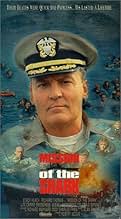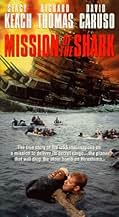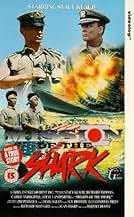Operation Haifisch - Lautlos kommt der Tod
Originaltitel: Mission of the Shark: The Saga of the U.S.S. Indianapolis
IMDb-BEWERTUNG
6,3/10
1008
IHRE BEWERTUNG
Füge eine Handlung in deiner Sprache hinzuTrue story of the sinking of the U.S.S. Indianapolis, its crew's struggle to survive the sharks and exposure, and the captain's scape-goat court-martial.True story of the sinking of the U.S.S. Indianapolis, its crew's struggle to survive the sharks and exposure, and the captain's scape-goat court-martial.True story of the sinking of the U.S.S. Indianapolis, its crew's struggle to survive the sharks and exposure, and the captain's scape-goat court-martial.
Joseph Carberry
- Spilner
- (as Joe Carberry)
Empfohlene Bewertungen
A true story worth telling, this movie suffers heavily from contrived dialog which was obviously written by someone unfamilar with the Navy. It's a classic example of writers who have learned most of what they think they know about their subject matter from watching previous movies which were just as likely written by still other writers who learned from watching still earlier movies, ad infinitum. The use of an Iowa-class battleship to portray an obsolescent pre-war heavy cruiser less than one-third its size didn't help, either.
One technical point: speaking as a former submariner and current submarine museum director, speed was always generally regarded a significant defense to submarine attack, and given the technology available at the time it was just plain bad luck as much as anything else that the Japanese were actually able to hit the INDIANAPOLIS. Note also that the submarine had to fire a total of six torpedoes to achieve two hits.
One last point: speaking as the survivor of a vicious wild-animal attack, I can attest that the fear of it is infinitely worse than its physical reality, and I could easily come up with a long list of worse ways to go - surely one would suffer worse from dehydration and exposure, to say nothing of what the medical profession is capable of doing to you once you get to a hospital.
***SPOILER ALERT *** Incidentally, McVay never recovered from the sinking. He committed suicide in 1968. In 2000 the United States Congress passed and the President signed a formal resolution exonerating him from blame for the sinking.
One technical point: speaking as a former submariner and current submarine museum director, speed was always generally regarded a significant defense to submarine attack, and given the technology available at the time it was just plain bad luck as much as anything else that the Japanese were actually able to hit the INDIANAPOLIS. Note also that the submarine had to fire a total of six torpedoes to achieve two hits.
One last point: speaking as the survivor of a vicious wild-animal attack, I can attest that the fear of it is infinitely worse than its physical reality, and I could easily come up with a long list of worse ways to go - surely one would suffer worse from dehydration and exposure, to say nothing of what the medical profession is capable of doing to you once you get to a hospital.
***SPOILER ALERT *** Incidentally, McVay never recovered from the sinking. He committed suicide in 1968. In 2000 the United States Congress passed and the President signed a formal resolution exonerating him from blame for the sinking.
The movie starts with a 15-year reunion of the men who served on the U.S.S. Indianapolis. Actually, many of the men are not there, and you will find out why when you watch. But the hero of this ship is Captain Charles McVay, and those who served under him cheer as he enters the room.
During World War II, the Indianapolis had an important mission. The sailors wonder why that box is so heavily guarded. There is lots of speculation; some claim it is special toilet paper for MacArthur. Down below, a high-ranking officer is informing McVay of something he seems to already know but won't confirm. That box contains the most deadly weapon ever developed. Those of us who know the outcome of World War II know exactly what that means.
There seems to be some disagreement on how best to avoid an attack by a Japanese sub. One sailor tells his superiors they are wrong in not trying to deceive the Japanese. Perhaps they should have listened to him, but he is sternly reminded who is in charge.
The Japanese are shown getting ready to attack, and perhaps the outcome of the war would have been somewhat different if they had succeeded. At this point, the sub commander doesn't believe an attack can succeed.
But the second time ...
In all the chaos, it's hard to believe anyone would have known what to do. Capt. McVay's attitude seems to be that abandoning ship would be the coward's way out. We know he survives to see the 15-year reunion. Eventually, it is clear there is only one course of action.
One would think the men would be rescued quickly, but there are procedures to keep the Japanese from knowing too much, and that may have contributed to a delay. So the men have more of an adventure than we might have expected.
This movie shows both sides of what it means to fight in a war. Stacy Keach gives a very strong performance as a leader who is tough but friendly and well-liked. How could anyone believe he was anything but a hero? But if you watch you'll find out some think he was not. There are plenty of courageous and even heroic actions, particularly those of the ship's doctor played by Richard Thomas. And then there are the men who need a leader to keep them from following their selfish desires. There are also cowards; you can't call them anything else. But would we do any better in such a situation?
Compared to "Saving Private Ryan", this would be a fireworks show on the Fourth of July gone awry followed by a dangerous kids' adventure at sea. It's hard to watch--this is war--but not graphic.
The Japanese seem cold and unfeeling, as one might expect. That's the image we have of them. But Hashimoto, who gave the order to fire on the Indianapolis, is shown to be human after all. He had a duty, and he succeeded. Not every time, but eventually. One scene with him later in the movie is pretty amazing.
This is certainly worth seeing.
During World War II, the Indianapolis had an important mission. The sailors wonder why that box is so heavily guarded. There is lots of speculation; some claim it is special toilet paper for MacArthur. Down below, a high-ranking officer is informing McVay of something he seems to already know but won't confirm. That box contains the most deadly weapon ever developed. Those of us who know the outcome of World War II know exactly what that means.
There seems to be some disagreement on how best to avoid an attack by a Japanese sub. One sailor tells his superiors they are wrong in not trying to deceive the Japanese. Perhaps they should have listened to him, but he is sternly reminded who is in charge.
The Japanese are shown getting ready to attack, and perhaps the outcome of the war would have been somewhat different if they had succeeded. At this point, the sub commander doesn't believe an attack can succeed.
But the second time ...
In all the chaos, it's hard to believe anyone would have known what to do. Capt. McVay's attitude seems to be that abandoning ship would be the coward's way out. We know he survives to see the 15-year reunion. Eventually, it is clear there is only one course of action.
One would think the men would be rescued quickly, but there are procedures to keep the Japanese from knowing too much, and that may have contributed to a delay. So the men have more of an adventure than we might have expected.
This movie shows both sides of what it means to fight in a war. Stacy Keach gives a very strong performance as a leader who is tough but friendly and well-liked. How could anyone believe he was anything but a hero? But if you watch you'll find out some think he was not. There are plenty of courageous and even heroic actions, particularly those of the ship's doctor played by Richard Thomas. And then there are the men who need a leader to keep them from following their selfish desires. There are also cowards; you can't call them anything else. But would we do any better in such a situation?
Compared to "Saving Private Ryan", this would be a fireworks show on the Fourth of July gone awry followed by a dangerous kids' adventure at sea. It's hard to watch--this is war--but not graphic.
The Japanese seem cold and unfeeling, as one might expect. That's the image we have of them. But Hashimoto, who gave the order to fire on the Indianapolis, is shown to be human after all. He had a duty, and he succeeded. Not every time, but eventually. One scene with him later in the movie is pretty amazing.
This is certainly worth seeing.
This is my first review, but I feel I must say something. Having just finished reading Doug Stanton's In Harm's Way, I see important opportunities missed in this film. There were true details omitted - probably for time's sake - that would have made this a more memorable film. For example, when the plane approaches a group of survivors, the crew seriously wonders who they are because their faces are smudged black from the huge oil slick that we never see in the film. As a test, a crew member calls out, "What city do the Dodgers play in?" A feeble voice answers, "Brooklyn." Wouldn't that have been a vintage, human touch?
Dr. Lewis Haynes, incorrectly named as mentioned by other reviewers, had a powerful but ignored role in helping the men to heal psychologically by explaining at reunions why so many turned on each other and acted like barbarians in the water. Most had been unaware that they were witnessing not the moral failings of their friends, but instead the effects of salt water ingestion, exposure to extreme heat, continuous lowering of body temperature, horrific fear, etc., on both body and mind. Add to that survivors' guilt and the Navy's total lack of caring. At that time nobody knew of PTSD.
Thus I mourn for what could have been done in this film. The one bright spot was Stacy Keach's acting. He was masterful and at his finest.
I believe we owe it to those who survived as well as to those who perished, and to their loved ones, to tell this story again on film, and GET IT RIGHT!
Dr. Lewis Haynes, incorrectly named as mentioned by other reviewers, had a powerful but ignored role in helping the men to heal psychologically by explaining at reunions why so many turned on each other and acted like barbarians in the water. Most had been unaware that they were witnessing not the moral failings of their friends, but instead the effects of salt water ingestion, exposure to extreme heat, continuous lowering of body temperature, horrific fear, etc., on both body and mind. Add to that survivors' guilt and the Navy's total lack of caring. At that time nobody knew of PTSD.
Thus I mourn for what could have been done in this film. The one bright spot was Stacy Keach's acting. He was masterful and at his finest.
I believe we owe it to those who survived as well as to those who perished, and to their loved ones, to tell this story again on film, and GET IT RIGHT!
This film is nicely filmed, though probably purposefully has the feel and look (and dialog) of a movie made in the 50s or 60s. Since the beginning and end are set in the 60s, I suspect that it was done on purpose. Scenes on the Indianapolis are fairly well done. The acting is a little stiff throughout, which is mostly due to a rather dry, stiff dialog and unimaginative script. They do manage to get the viewer steamed up at the Navy at the Court Marshall of Captain McVay. The film leaves a bit to be desired, but the saddest part of the tale is that the horror is true and teh abhorent behavior of the US Navy was unforgivable, even as of 1991. I have no idea whether the record or memory of McVay has been cleared since, but it certainly should be. The film makes a strong statement about the horrible costs of war.
Remember the boys out on Quint's boat? At night, down below, swapping seagoing yarns, showing their scars, knowing the shark is out there, waiting in the watery night, guys talk of exploits and escapes. Joining in, the Roy Schieder character naively questions, "What's that one?" noticing another tattoo on Quint's forearm, The USS Indianapolis. Quint tells the tragic story of that WWII ship and crew. His personal motivation as a shark hunter.
Well, if you want more of the story, that's what Mission of the Shark delivers. It is a nicely crafted historical drama with high marks for historical accuracy. Stacy Keach is wonderful as the captain, a tragic figure with biblically bad luck.
Well, if you want more of the story, that's what Mission of the Shark delivers. It is a nicely crafted historical drama with high marks for historical accuracy. Stacy Keach is wonderful as the captain, a tragic figure with biblically bad luck.
Wusstest du schon
- WissenswertesThis is the very mission that Quint (Robert Shaw) talked about being a member of in a famous scene from Jaws (1975).
- PatzerIn the scene where a seaplane lands at sea to rescue the crew, the plane used is a Grumman Albatross. However, this aircraft was not put into service until 1949. The real life aircraft that rescued the crew, was a Catalina PBY.
- Zitate
Hashimoto: Captain. You are a man who believes in fate?
Capt. Charles Butler McVay: No. I'm a man who was trying to accept it.
Hashimoto: It is not easy being a survivor.
- Crazy Credits(Contents of Title Card 1) Following the U.S.S. Indianapolis tragedy the U.S. Navy discontinued its policy of not reporting arriving non-combat ships.
- VerbindungenEdited from Enola Gay - Bomber des Todes (1980)
Top-Auswahl
Melde dich zum Bewerten an und greife auf die Watchlist für personalisierte Empfehlungen zu.
Details
- Erscheinungsdatum
- Herkunftsland
- Sprachen
- Auch bekannt als
- U.S.S. Indianapolis - Lautlos kommt der Tod
- Drehorte
- Produktionsfirmen
- Weitere beteiligte Unternehmen bei IMDbPro anzeigen
Zu dieser Seite beitragen
Bearbeitung vorschlagen oder fehlenden Inhalt hinzufügen

Oberste Lücke
By what name was Operation Haifisch - Lautlos kommt der Tod (1991) officially released in Canada in English?
Antwort

































